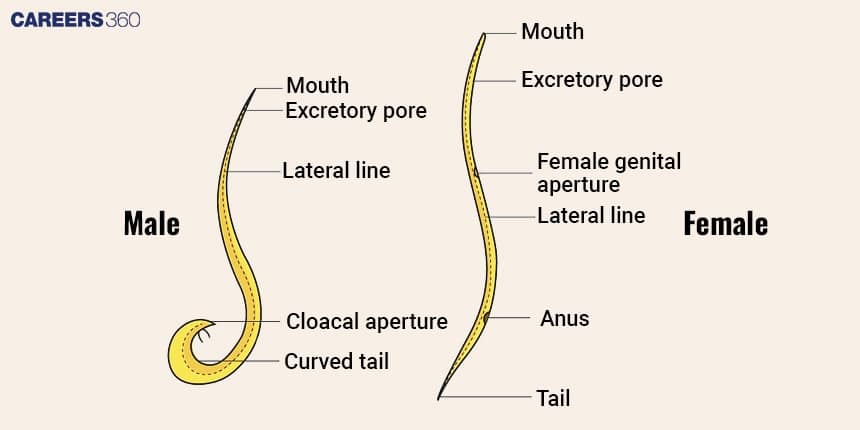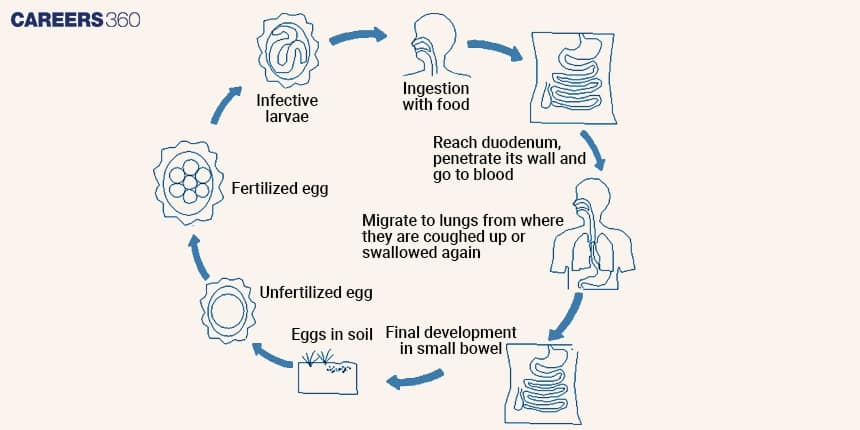Ascaris life cycle - Symptoms & Types
Ascaris lumbricoides is a parasitic nematode roundworm that infects the intestines of humans. It is one of the largest and most prevalent intestinal parasites. This organism is the causative agent of ascariasis, a prevalent intestinal infection in humans. The life cycle of Ascaris lumbricoides is complex, involving both larval and adult stages. Ascaris is one of the important parts of the Animal Kingdom in Biology. We will be discussing all the important aspects of Ascaris life cycle in detail down below
NEET 2025: Mock Test Series | Syllabus | High Scoring Topics | PYQs
NEET Important PYQ's Subject wise: Physics | Chemistry | Biology
New: Meet Careers360 B.Tech/NEET Experts in your City | Book your Seat now
- What is Ascaris lumbricoides ?
- Taxonomic Classification
- Physical Characteristics
- Life Cycle of Ascaris lumbricoides
- Pathogenesis
- Preventative Measures
- Tips, Tricks, and Strategies for Ascaris Life Cycle
- Recommended Video On Ascaris Lumbricoids

What is Ascaris lumbricoides ?
Ascaris lumbricoides is an important roundworm because it causes a serious human disease problem called ascariasis. It causes malnutrition and stunted growth, alongside other serious health complications, especially in children. In tropical and subtropical areas, Ascaris infects about 1.2 billion people worldwide, especially in areas with bad and unsanitary hygiene practices.
Also Read
Taxonomic Classification
Kingdom: Animalia
Phylum: Nematoda
Class: Secernentea
Order: Ascaridida
Family: Ascarididae
Genus: Ascaris
Species: A. lumbricoides
Physical Characteristics
The adult Ascaris worms are cylindrical with a smooth, striated cuticle. The male measures 15-31 cm, while the female is a bit longer at 20-49 cm.
Males are smaller, with the posterior end of the body curved, while females are straight. Males possess spicules used in copulation.
ancylostoma duodenal is also a type of ascaris which quite famous
Diagram of Ascaris Lumbricoides
The diagram given below shows the structural difference between the male and female body structure of Ascaris Lumbricoidis.

Life Cycle of Ascaris lumbricoides
There are many stages in the life cycle of ascaris :
Ingestion
This worm's eggs are not contagious until they come into touch with soil. Someone can contract the virus through the soil vegetable or any other manner if they come into contact with such contaminated soil by eating any fruit or vegetable that was growing in it.
Migration
The second stage of the ascaris life cycle is referred to as migration. Migration is the process by which the egg enters the organ.
Once the eggs have hatched, they move into the small intestine where the larva stage is being produced. With the assistance of the small intestine's intestinal wall, they now begin to enter the lungs.
Maturation
These larvae reach their maturation stage when they are ingested by a human. Now, these larvae return to the small intestine where they grow into either the male or female ascaris worm. Male worms are often shorter than female worms, which average about 15 inches in length.
Reproduction
As a final step, the reproduction now takes place in the small intestine. Each day, female ascaris worms release into the human body roughly 2 lakh eggs.
The fertilized egg remains in the soil for at least 18 days before becoming infected. At this point, the egg's larva is excreted out through human faeces.
The entire procedure of this reproduction takes about 3 months.
Diagram Of The Life Cycle Of Ascaris lumbricoides

Pathogenesis
Ascaris lumbricoides are transmitted via the faecal-oral route; that is, mono-infection ensues on ingesting food or water contaminated by faeces from the eggs.
These include poor sanitation, lack of clean water, and residence in endemic areas.
Abdominal pain, nausea, emesis, and low-grade fever may be present.
Serious stage may lead to intestinal blockage, malnutrition, and growth retardation in children.
This may lead to larval migration with pulmonary complications like pneumonitis and, occasionally, liver or pancreatic involvement.
Symptoms of Ascariasis
There are two different types of ascariasis:
Intestinal Ascariasis
There are many different symptoms of this type of ascariasis, including vomiting and gas.
Symptoms also include weight loss and diarrhoea.
Malabsorption of food can also be observed in this type of ascariasis.
Sometimes it is also observed that growth retardation occurs as well. Nausea is the main symptom that is followed in this type of ascariasis.
Pulmonary Ascariasis
In this type of ascariasis fever that is persistently high is one of the major symptoms that can be seen within a few hours of infection.
Mode Of Infection Of Ascaris Lumbricoides
Infection occurs by swallowing fully developed Ascaris eggs covered with shells. These eggs are consumed with raw vegetables and by drinking water contaminated with roundworms.
This worm can go straight to the mouth with the dirty fingers dipped in the soil. The risk of ascariasis is observed more often in children than in adults. The infection takes place through contaminated food, uncooked food and raw food. It can also be spread through canned food.
Incubation Period Of Ascaris Lumbricoides
It takes Ascaris lumbricoides between 60 and 75 days to infect a man. This incubation period begins at the point of infection exposure and lasts until the mature female lays her eggs and symptoms can be seen. This is the time when it multiplies and causes disease.
Preventative Measures
Importance of hand washing, clean water for washing, and food washing.
Mass deworming programs at the school or community level could make a difference in reducing prevalence.
Infections can be prevented through raising awareness about hygiene and sanitation.
Among the most important parasitic nematodes causing high disease burden, particularly in children in endemic areas, is Ascaris lumbricoides. The diagnosis, treatment, and prevention of the infection require an awareness of its life cycle, transmission, and clinical manifestations.
There is a continuous need for research into improved treatments and vaccines against these infections. Public health initiatives are major tools in reducing the global burden of ascariasis.
Future efforts need to concentrate on ensuring better and sustainable sanitation facilities, promoting education, and developing new antihelminthic drugs and vaccines against Ascaris lumbricoides for effective control.
Tips, Tricks, and Strategies for Ascaris Life Cycle
It takes effort to remember everything in a single go. We made the entire problem easy. Some of the tricks regarding the Ascaris life cycle are given below which you can use to memorise the important points.
Ascaris: "HELPS: Host, Eggs, Lifecycle, Pathology, Symptoms"
H: Host (lives in human intestines)
E: Eggs (released in faeces and can survive in soil)
L: Lifecycle (eggs are ingested, larvae hatch in the intestines, travel through the lungs, and return to the intestines to mature)
P: Pathology (causes malnutrition, blockage, and respiratory symptoms)
S: Symptoms (abdominal pain, cough, malnutrition)
Also Read
Recommended Video On Ascaris Lumbricoids
Frequently Asked Questions (FAQs)
Ascaris Male : The male of ascaris is typically 15-30 cm long. These are found to be about 3-4 mm size in diameter. Tail of male ascaris is typically curved.
Female :The female of ascaris is 20-40 cm length. They are about 2-6mm in diameter. Tail of the feminine ascaris is straight. Females are founded out to be longer in length than male
Symptoms include abdominal pain, nausea, vomiting, diarrhoea, and in severe cases, intestinal blockage and malnutrition
It takes Ascaris lumbricoides between 60 and 75 days to infect a man. This time span begins at the point of infection exposure, when the mature female produces eggs, and ends when symptoms are noticed.
Two species of ascaris is present namely
Ascaris lumbricoides in human
Ascaris suum in pig
Man is found to contain the A.lumbricoides species, which infects the man. Pigs are discovered to be the secondary host for the Ascaris sum. species. Despite having many physical similarities, these two species represent different physiological strains of the ascaris genus. Both the Ascaris suum and Ascaris lumbricoides infected eggs will not hatch in humans or pigs.
The life cycle includes ingestion of eggs, larval migration through the bloodstream to the lungs, the ascent to the throat, and return to the intestines where they mature into adults.
Also Read
29 Nov'24 12:52 PM
26 Nov'24 04:23 PM
26 Nov'24 04:19 PM

